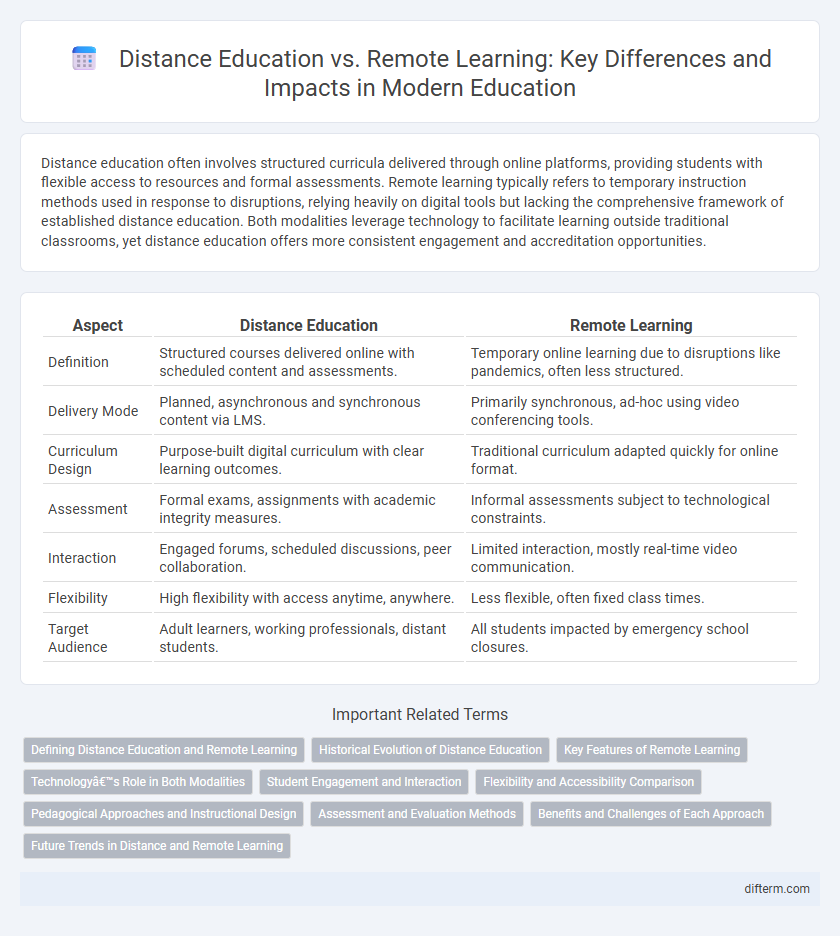Distance education often involves structured curricula delivered through online platforms, providing students with flexible access to resources and formal assessments. Remote learning typically refers to temporary instruction methods used in response to disruptions, relying heavily on digital tools but lacking the comprehensive framework of established distance education. Both modalities leverage technology to facilitate learning outside traditional classrooms, yet distance education offers more consistent engagement and accreditation opportunities.
Table of Comparison
| Aspect | Distance Education | Remote Learning |
|---|---|---|
| Definition | Structured courses delivered online with scheduled content and assessments. | Temporary online learning due to disruptions like pandemics, often less structured. |
| Delivery Mode | Planned, asynchronous and synchronous content via LMS. | Primarily synchronous, ad-hoc using video conferencing tools. |
| Curriculum Design | Purpose-built digital curriculum with clear learning outcomes. | Traditional curriculum adapted quickly for online format. |
| Assessment | Formal exams, assignments with academic integrity measures. | Informal assessments subject to technological constraints. |
| Interaction | Engaged forums, scheduled discussions, peer collaboration. | Limited interaction, mostly real-time video communication. |
| Flexibility | High flexibility with access anytime, anywhere. | Less flexible, often fixed class times. |
| Target Audience | Adult learners, working professionals, distant students. | All students impacted by emergency school closures. |
Defining Distance Education and Remote Learning
Distance education refers to structured academic programs delivered through formal systems where students and instructors are geographically separated, often involving scheduled lessons, assessments, and accreditation. Remote learning is a flexible, temporary approach typically used during emergencies, allowing students to access educational content and engage with teachers via digital platforms without fixed schedules. Both models leverage technology but differ in intent, structure, and long-term implementation within the education system.
Historical Evolution of Distance Education
Distance education originated in the 19th century with correspondence courses using postal mail to deliver instructional materials, enabling access to education beyond traditional classrooms. The advent of radio and television in the 20th century introduced broadcast-based distance learning, expanding reach and interaction possibilities. The rise of the internet and digital technologies since the late 1990s transformed distance education into modern remote learning, integrating real-time communication, multimedia content, and interactive platforms to enhance engagement and accessibility.
Key Features of Remote Learning
Remote learning utilizes digital platforms to facilitate real-time interaction between students and instructors, emphasizing synchronous communication and immediate feedback. It often incorporates multimedia tools such as video conferencing, interactive quizzes, and discussion boards to enhance engagement and collaboration. Unlike distance education, which may include asynchronous content delivery, remote learning relies heavily on scheduled virtual classes and active participation to replicate traditional classroom dynamics.
Technology’s Role in Both Modalities
Technology serves as the backbone for both distance education and remote learning, enabling interactive platforms, digital resources, and real-time communication tools essential for effective instruction beyond traditional classrooms. Distance education often relies on asynchronous technologies such as learning management systems, video lectures, and online assessments that allow learners to access content flexibly. Remote learning, typically synchronous, leverages video conferencing software, collaborative apps, and immediate feedback mechanisms to replicate the classroom experience in a virtual environment.
Student Engagement and Interaction
Distance education often incorporates structured coursework and scheduled assessments, promoting consistent student engagement through well-defined curricula. Remote learning, typically implemented during emergency situations, may struggle to maintain interaction levels due to limited access to interactive tools and real-time communication. Enhancing student engagement in both modalities relies heavily on integrating multimedia resources, interactive platforms, and synchronous discussions to foster a collaborative learning environment.
Flexibility and Accessibility Comparison
Distance education offers greater flexibility by allowing students to access coursework anytime and anywhere, accommodating diverse schedules and learning paces. Remote learning typically requires synchronous attendance, limiting accessibility for students with time zone differences or fixed commitments. Both models enhance educational reach, but distance education excels in providing adaptable, self-paced learning environments that improve accessibility for a broader student population.
Pedagogical Approaches and Instructional Design
Distance education prioritizes asynchronous learning models, leveraging comprehensive instructional design that incorporates multimedia resources and self-paced modules to enhance learner autonomy. Remote learning often relies on synchronous sessions using video conferencing tools, emphasizing real-time interaction but sometimes limiting flexibility and individualized pacing. Effective pedagogical approaches for distance education integrate constructivist and competency-based strategies, whereas remote learning tends to adopt traditional lecture formats adapted for digital communication platforms.
Assessment and Evaluation Methods
Distance education employs structured, formal assessment methods such as proctored exams, standardized tests, and comprehensive project submissions to ensure academic integrity and consistent evaluation standards. Remote learning often utilizes more flexible, technology-driven evaluation tools including online quizzes, interactive assignments, and real-time feedback mechanisms to adapt to diverse student environments. Both approaches integrate digital platforms, but distance education emphasizes rigorous monitoring, whereas remote learning prioritizes accessibility and immediate assessment responses.
Benefits and Challenges of Each Approach
Distance education offers flexible scheduling and access to diverse resources, making it ideal for self-motivated learners and those with geographic or time constraints. Remote learning often relies on synchronous sessions, fostering real-time interaction but posing challenges such as technical issues and reduced social engagement. Both approaches demand strong digital literacy and self-discipline, yet distance education emphasizes asynchronous materials while remote learning centers on live participation.
Future Trends in Distance and Remote Learning
Future trends in distance education and remote learning highlight the integration of artificial intelligence and adaptive learning technologies to personalize student experiences. Virtual reality and augmented reality platforms are expected to enhance immersive learning environments, increasing engagement and retention rates. Growth in mobile learning and 5G connectivity will further facilitate real-time interaction and accessibility for learners worldwide.
Distance education vs remote learning Infographic

 difterm.com
difterm.com